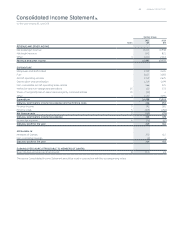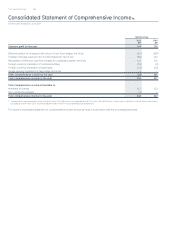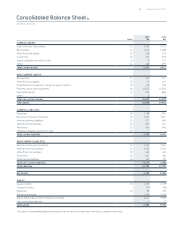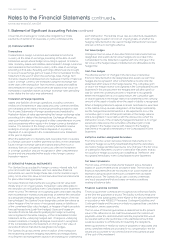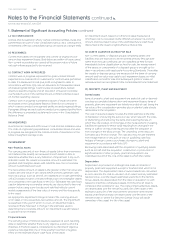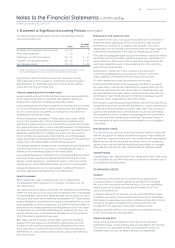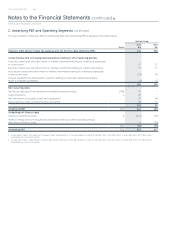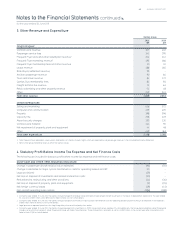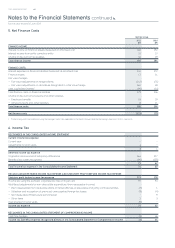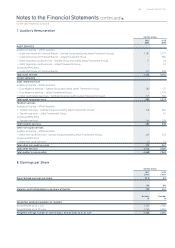Qantas 2011 Annual Report Download - page 61
Download and view the complete annual report
Please find page 61 of the 2011 Qantas annual report below. You can navigate through the pages in the report by either clicking on the pages listed below, or by using the keyword search tool below to find specific information within the annual report.
59 ANNUAL REPORT 2011
for the year ended 30 June 2011
Notes to the Financial Statements continued
1. Statement of Signicant Accounting Policies continued
The principal asset depreciation periods and estimated residual
value percentages are:
Years
Residual
Value (%)
Buildings and leasehold improvements –
Plant and equipment –
Passenger aircraft and engines . – –
Freighter aircraft and engines . – –
Aircraft spare parts – –
. Certain leases allow for the sale of leasehold improvements for fair value. In these
instances the expected fair value is used as the estimated residual value.
Depreciation rates and residual values are reviewed annually
and reassessed having regard to commercial and technological
developments, the estimated useful life of assets to the Qantas
Group and the long-term eet plan.
Finance Leased and Hire Purchase Assets
Leased assets under which the Qantas Group assumes substantially
all the risks and benets of ownership are classied as nance
leases. Other leases are classied as operating leases.
Linked transactions involving the legal form of a lease are accounted
for as one transaction when a series of transactions are negotiated
as one or take place concurrently or in sequence and cannot be
understood economically alone.
Finance leases are capitalised. A lease asset and a lease liability
equal to the present value of the minimum lease payments and
guaranteed residual value are recorded at the inception of the lease.
Any gains and losses arising under sale and leaseback arrangements
are deferred and depreciated over the lease term. Capitalised leased
assets are depreciated on a straight-line basis over the period in
which benets are expected to arise from the use of those assets.
Lease payments are allocated between the reduction in the principal
component of the lease liability and the interest element.
The interest element is charged to the Consolidated Income Statement
over the lease term so as to produce a constant periodic rate of
interest on the remaining balance of the lease liability.
Fully prepaid leases are classied in the Consolidated Balance Sheet
as hire purchase assets, to recognise that the nancing structures
impose certain obligations, commitments and/or restrictions on the
Qantas Group, which differentiate these aircraft from owned assets.
Leases are deemed to be non-cancellable if signicant nancial
penalties associated with termination are anticipated.
Operating Leases
Rental payments under operating leases are charged to the
Consolidated Income Statement on a straight-line basis over the
term of the lease.
Any gains and losses arising under sale and leaseback arrangements
where the sale price is at fair value are recognised in the Consolidated
Income Statement as incurred. Where the sale price is below fair value,
any gains and losses are immediately recognised in the Consolidated
Income Statement, except where the loss is compensated for by future
lease payments at below market price, it is deferred and amortised in
proportion to the lease payments over the period for which the asset
is expected to be used. Where the sale price is above fair value, the
excess over fair value is deferred and amortised over the period for
which the asset is expected to be used.
With respect to any premises rented under long-term operating
leases, which are subject to sub-tenancy agreements, provision
is made for any shortfall between primary payments to the head
lessor less any recoveries from sub-tenants. These provisions are
determined on a discounted cash ow basis, using a rate reecting
the cost of funds.
Maintenance and Overhaul Costs
An element of the cost of an acquired aircraft (owned and nance
leased aircraft) is attributed to its service potential, reecting the
maintenance condition of its engines and airframe. This cost is
depreciated over the shorter of the period to the next major inspection
event or the remaining life of the asset or remaining lease term.
The costs of subsequent major cyclical maintenance checks for owned
and leased aircraft (including operating leases) are capitalised and
depreciated over the shorter of the scheduled usage period to the
next major inspection event or the remaining life of the aircraft or
lease term (as appropriate).
Maintenance checks, which are covered by the third party
maintenance agreements where there is a transfer of risk and
legal obligation, are expensed on the basis of hours own.
All other maintenance costs are expensed as incurred.
Modications that enhance the operating performance or extend
the useful lives of aircraft are capitalised and depreciated over the
remaining estimated useful life of the asset or remaining lease term
(as appropriate). Manpower costs in relation to employees who are
dedicated to major modications to aircraft are capitalised as part
of the cost of the modication to which they relate.
With respect to operating lease agreements, where the Qantas Group
is required to return the aircraft with adherence to certain maintenance
conditions, provision is made during the lease term. This provision is
based on the present value of the expected future cost of meeting
the maintenance return condition, having regard to the current eet
plan and long-term maintenance schedules. The present value of
non-maintenance return conditions is provided for at the inception
of the lease.
Manufacturers’ Credits
The Qantas Group receives credits from manufacturers in connection
with the acquisition of certain aircraft and engines. These credits are
recorded as a reduction to the cost of the related aircraft and engines.
Where the aircraft are held under operating leases, the credits are
deferred and reduced from the operating lease rentals on a straight-
line basis over the period of the related lease as deferred credits.
Capital Projects
Capital projects are disclosed within the categories to which they relate
and are stated at cost. When the asset is ready for its intended use, it
is capitalised and depreciated.
Q INTANGIBLE ASSETS
Goodwill
All business combinations are accounted for by applying the
acquisition method. Goodwill represents the difference between
the cost of the acquisition and the fair value of the net identiable
assets acquired. Goodwill acquired before transition to IFRS is
carried at deemed cost.
Goodwill is stated at cost less any accumulated impairment losses.
Goodwill is allocated to CGUs and is tested annually for impairment.
With respect to associates and jointly controlled entities, the carrying
amount of goodwill is included in the carrying amount of the
investment in the associate or the jointly controlled entity.
Negative goodwill arising on an acquisition is recognised directly
in the Consolidated Income Statement.
Airport Landing Slots
Airport landing slots are stated at cost less any accumulated
impairment losses. Airport landing slots are allocated to the relevant
CGU and are not amortised as they are considered to have an
indenite useful life and are tested annually for impairment.


